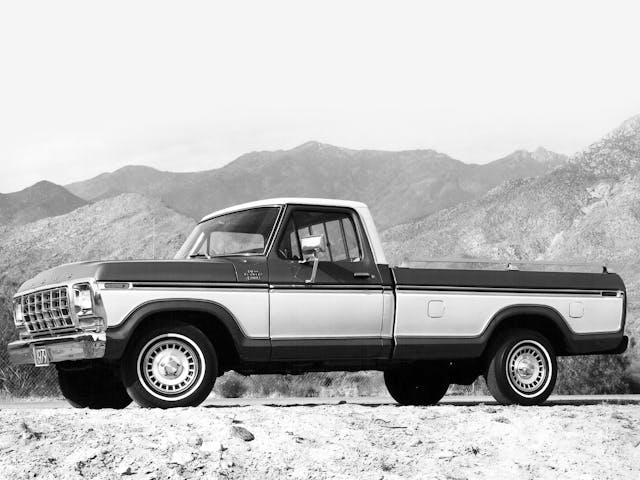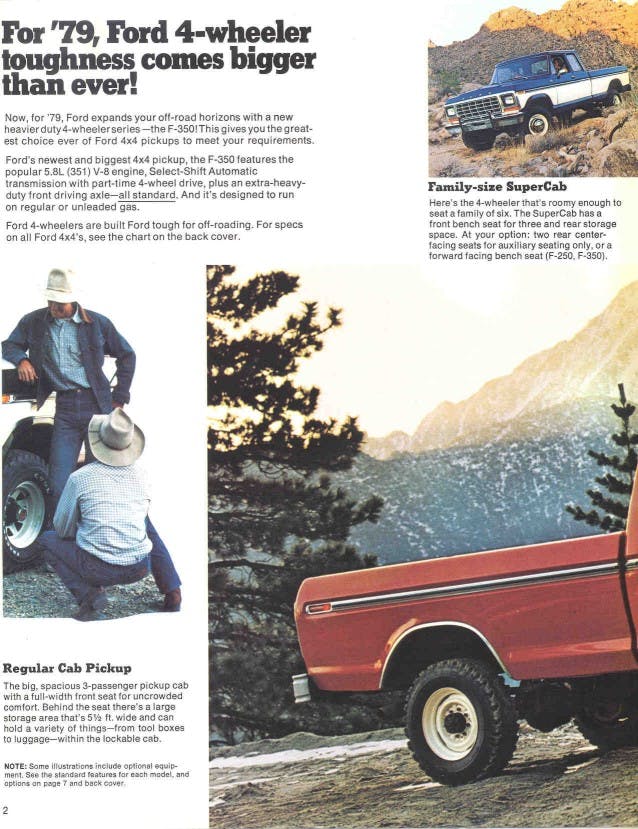Ford’s ’73–79 F-Series just won’t quit
Ford has no shortage of nameplates that get enthusiasts going. Mustang and GT40 are the obvious standouts, while the utilitarian Bronco is not far behind. That said, there’s another, more workaday model that’s captured our attention and is lighting up the value charts: Ford’s venerable sixth-generation F-Series.
In 1977, these trucks grabbed the pickup sales mantle for Ford, and the F-Series hasn’t looked back since. (Coming from a GM family, I’m obliged to point out there have been more than a couple years during that period when sales of the GMC and Chevy twins have together beaten those of the cross-town Ford; the Blue Oval only “wins” because GM’s trucks are technically two different models. But I digress.) Taking a conservative approach by using much of the same underpinnings as the previous generation, these “Dentside” Fords—so named for the indentation running the length of the body—were nonetheless a smash hit and rounded out the Ford truck hierarchy as we now know it.

Additional bed options (and a longer wheelbase) for the workhorse F-350 model were available from the generation’s debut in 1973, and the now-ubiquitous F-150 debuted in 1975. Trim levels changed over the course of the seven-year model run but included Custom, Ranger, Ranger XLT, and Ranger Lariat. The Lariat was about as decked-out as you could option a pickup then, with two-tone paint and a plush interior. As you can see from the brochure below, a variety of cabs, bed lengths, and bed styles met a broad swath of consumer needs.
Ford put an array of engines under Dentside hoods over the course of its seven-year production run: 240- and 300-cubic-inch sixes plus 302-, 351-, 360-, 390-, 400-, and 460-cubic-inch V-8s gave buyers plenty to choose from. For those who are shopping for these trucks today, engine differences make for slight variations in valuation, but while a 460 gets you bragging rights, there are worse things than tooling around with a 302 or a bulletproof Ford six-cylinder.
The exterior of these rigs benefited from extensive use of galvanized steel and rust-resistant coatings. Ford updated the Dentside F-Series’ look with mild tweaks to the grille in 1976 and again in 1978—this, along with the constant updating of engine and trim levels, helped keep the platform feeling fresh, even though it dated back to 1965.
Ford’s cover-all-bases approach (covered in great detail in our recent buyer’s guide on the Dentside) was a success then, and the truck is seeing renewed popularity now. That’s not just a generalized, pandemic-era-raised-all-prices statement, either—the sixth-gen F-Series is actually ticking up in value as the market has begun to come back down.
The rise of SUVs and old pickups as collector vehicles is nothing new, and Ford’s original Bronco was among the first to see values jump. As six-figure prices for Bronco or FJ40 Toyota Land Cruisers got people used to the idea that ’60s and ’70s collectibles weren’t limited to muscle and sports cars, values slowly began to rise for that era’s pickups as well.
Fast forward to now. Though the early darlings of the collector truck movement have lost some steam (#2-quality, Excellent condition first-gen Broncos are down 13 percent for the original Bronco in the last year, and FJ40 values are down just under ten percent), a similar condition F-150 4×4 with a 351-cubic inch engine is up 20 percent over the same period. The same F-150 in #3 condition is up nearly four percent.

The Dentside fares well against its contemporaries, too. Equivalent Dodge W- and D150 models (which are near to my heart after helping my cousin restore his—check out that story here) have been flat over the last year, and can be had for ten to twenty grand less depending on condition. Chevy’s K10 half-ton tracks the Ford more closely—it’s up nine percent for #2 and #3 conditions, though it’s still thousands cheaper than the Dentside.
The F-Series benefits from a very healthy set of buyer demographics. Younger buyers represent a full 40 percent of the market, while Gen X and baby boomers retain healthy shares as well. These trucks are nearly universally appreciated, and that pattern suggests they’ll continue to have a positive valuation outlook.
Are there more affordable classic trucks out there? Yes, there are. But if you love the ’73–79 F-Series’s looks and are good with a driver-quality example (you are going to use your classic truck as a truck, right?), you can still find decent examples in the teens. Besides, given how well-liked they appear to be across all ages, you’re likely to get out what you put into it. That’s the value of a good name.

***
Check out the Hagerty Media homepage so you don’t miss a single story, or better yet, bookmark it. To get our best stories delivered right to your inbox, subscribe to our newsletters.





I bought a new 1978 4×4 F150, 4-speed, 400cid piece of junk! Engine constantly overheated, rear axles kept blowing the outer bearings. The Reno dealer service sucked, I was a pro mechanic on European cars, but needed a new truck after 225,000 miles on my 1973 GMC 4×4, equipped the same way. The GMC was a better truck, but new ones weren’t available at the time I needed a truck. Sold the Ford after 1 year, and said good riddance.
I have 75 Ford 4×4 with a 360 150,000 miles on it with no trouble ever. I also have a pos. 75 chevy with a 350. with 70,000 miles. So many thinks wrong with to mention. Its going to the junk yard next week.
I have a 1977 f-150 4×4 short bed, owned it for about ten years. replaced the transplanted 460 for a slightly built 400. The 400 is what the truck originally came with, and it fit so much better than the 460 ever did.
Been working on it for years, kinda got it where I want it and have been putting the miles on it lately. It’s a real head turner and super fun to drive.
I got fuel injection (holly sniper) and two gas tanks both retrofitted with in tank pumps. I was able to purchase the back tank ready for EFI, the behind the seat tank was a different story. I had to drill hole and fit the pump assembly, very difficult on a tank that is so narrow. It’s ugly but it works. I used the tank selector valve used for later model trucks and had to wire a double pole double throw relay to make it work with the dash switch.
Got a 4″ lift, 37″ tires with 18″ rims. Looks and sounds cool and goes really well.